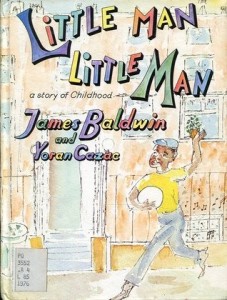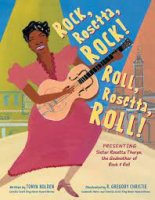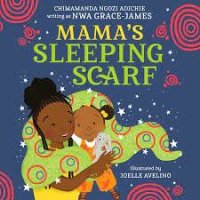Depicts the environment and daily life of two boys coming of age in Harlem.--from the publisher
96 pages 978-0803748590 Ages 10-14
***********
This reprint of the 1976 collaboration between Baldwin and artist friend Yoran Cazac was interesting historically, not only from the point of view of seeing inner city scenes from the 1970s, but because the book was written for Baldwin's nephew so that he could see himself in a book. Over forty years later, we are still struggling to find books that portray all readers.
Four-year-old TJ is given free rein to explore his lively Harlem neighborhood with his friend WT and neighbor Blinky (so called because of her glasses). While they don't roam far, the freedom that they are given to talk to people, go to stores, and be unsupervised will seem odd to children today. Their neighborhood is not entirely safe-- at one point, the children see a man who was shot, and WT injures his foot on a broken bottle that falls off a roof because a woman with a drinking problem is trying to hide them from her husband. What is particularly interesting is the social network that the children have. They buy groceries for an elderly neighbor, Miss Beanpole, and even go into her home, which is darkened and secured, which indicates her distrust of the area. While TJ's own parents are supportive and present (there is a nice scene of Sunday morning breakfast), WT's mother is absent and his father is abusive. In addition to Miss Beanpole and the grocer, the children also often interact with Mr. Man and Miss Lee. These adults have their own problems (Miss Lee is the one hiding the bottles), but are kind to the children.
Styles in literature change dramatically over the years, so this format might strike the modern reader as something different. It's a picture book, but one which is too long to read to young children. It has very young characters, but the situations they face are more in tune with what older readers might find interesting. It is a book that is more episodic than plot driven, and concerned with detailing the minutiae of TJs life rather than being concerned with a plot driven narrative. The pictures definitely seem fresh because illustration styles have also changed-- Cazac's line drawings are similar to illustrations with which I am familiar from 1960s books, but have more color and activity added to them.
Reviews at the time mentioned that this book "lacked focus", and I can see that, but it is a valuable book to read. The language arts teachers in my school like to have students read historical fiction (including stories that were written long enough ago to become "historical"-- and that could be a book that is two years old!) to gain perspective on how daily life and culture were different, and how this can influence the choices that characters make. Little Man, Little Man is interesting because it is a rare primary source snapshot of a particular place and time.
To get an idea of what the atmosphere in children's publishing was like in the early 1970s, I highly recommend reading Augusta Baker's 1974 essay for The Horn Book, The Changing Image of the Black in Children’s Literature. (https://www.hbook.com/1975/02/choosin...)






